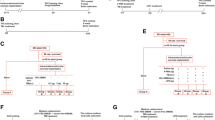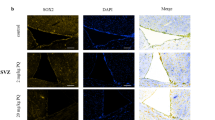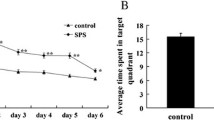Abstract
Stress induces structural plasticity in neurons of the adult central nervous system (CNS) and alters the levels of cellular production of reactive oxygen species (ROS), and these changes might involve modifications of the antioxidant defense system. This study investigated whether acute stress altered the expression pattern of peroxiredoxin (Prx) III, which is an antioxidant enzyme that controls cytokine-induced peroxide levels. Prx III immunoreactivity was upregulated in the pyramidal neurons of the hippocampus and in the motor neurons of the spinal cord in an acute immobilization stress (AIS) model. In addition, we tested whether the transcription factor Foxo3a was necessary for the expression of Prx III. The depletion of Foxo3a led to a marked reduction of Prx III and a compensatory enhancement of mitochondrial superoxide dismutase (Mn-SOD) in PC12 cells. The results of this study suggest that Foxo3a mediates the neuronal levels of expression of Prx III and the levels of expression of Mn-SOD in mitochondria. These mechanisms may play an important role in neuroprotection against oxidative stress. Furthermore, Prx III upregulation might be an useful approach for the management of stress.



Similar content being viewed by others
References
Bryk R, Griffin P, Nathan C (2000) Peroxynitrite reductase activity of bacterial peroxiredoxins. Nature 407:211–215
Chae HZ, Kim HJ, Kang SW, Rhee SG (1999) Characterization of three isoforms of mammalian peroxiredoxin that reduce peroxides in the presence of thioredoxin. Diabetes Res Clin Pract 45:101–112
Chaturvedi RK, Beal MF (2008) Mitochondrial approaches for neuroprotection. Ann N Y Acad Sci 1147:395–412
Chiribau CB, Cheng L, Cucoranu IC, Yu YS, Clempus RE, Sorescu D (2008) FOXO3A regulates peroxiredoxin III expression in human cardiac fibroblasts. J Biol Chem 283:8211–8217
De Cristobal J, Madrigal JL, Lizasoain I, Lorenzo P, Leza JC, Moro MA (2002) Aspirin inhibits stress-induced increase in plasma glutamate, brain oxidative damage and ATP fall in rats. Neuroreport 13:217–221
Figueiredo HF, Dolgas CM, Herman JP (2002) Stress activation of cortex and hippocampus is modulated by sex and stage of estrus. Endocrinology 143:2534–2540
Hattori F, Murayama N, Noshita T, Oikawa S (2003) Mitochondrial peroxiredoxin-3 protects hippocampal neurons from excitotoxic injury in vivo. J Neurochem 86:860–868
He XH, Tay SS, Ling EA (1997) Expression of NADPH-diaphorase and nitric oxide synthase in lumbosacral motoneurons after knee joint immobilisation in the guinea pig. J Anat 191(Pt 4):603–610
Jin MH, Lee YH, Kim JM, Sun HN, Moon EY, Shong MH, Kim SU, Lee SH, Lee TH, Yu DY, Lee DS (2005) Characterization of neural cell types expressing peroxiredoxins in mouse brain. Neurosci Lett 381:252–257
Kim JJ, Diamond DM (2002) The stressed hippocampus, synaptic plasticity and lost memories. Nat Rev Neurosci 3:453–462
Kops GJ, Dansen TB, Polderman PE, Saarloos I, Wirtz KW, Coffer PJ, Huang TT, Bos JL, Medema RH, Burgering BM (2002) Forkhead transcription factor FOXO3a protects quiescent cells from oxidative stress. Nature 419:316–321
Kwon MS, Seo YJ, Lee JK, Lee HK, Jung JS, Jang JE, Park SH, Suh HW (2008) The repeated immobilization stress increases IL-1beta immunoreactivities in only neuron, but not astrocyte or microglia in hippocampal CA1 region, striatum and paraventricular nucleus. Neurosci Lett 430:258–263
Liu PK, Robertson CS, Valadka A (2002) The association between neuronal nitric oxide synthase and neuronal sensitivity in the brain after brain injury. Ann N Y Acad Sci 962:226–241
McMahon A, Kvetnansky R, Fukuhara K, Weise VK, Kopin IJ, Sabban EL (1992) Regulation of tyrosine hydroxylase and dopamine beta-hydroxylase mRNA levels in rat adrenals by a single and repeated immobilization stress. J Neurochem 58:2124–2130
Mesches MH, Fleshner M, Heman KL, Rose GM, Diamond DM (1999) Exposing rats to a predator blocks primed burst potentiation in the hippocampus in vitro. J Neurosci 19:RC18
Nankova B, Kvetnansky R, Hiremagalur B, Sabban B, Rusnak M, Sabban EL (1996) Immobilization stress elevates gene expression for catecholamine biosynthetic enzymes and some neuropeptides in rat sympathetic ganglia: effects of adrenocorticotropin and glucocorticoids. Endocrinology 137:5597–5604
Nemoto S, Combs CA, French S, Ahn BH, Fergusson MM, Balaban RS, Finkel T (2006) The mammalian longevity-associated gene product p66shc regulates mitochondrial metabolism. J Biol Chem 281:10555–10560
Pierrou S, Hellqvist M, Samuelsson L, Enerback S, Carlsson P (1994) Cloning and characterization of seven human forkhead proteins: binding site specificity and DNA bending. EMBO J 13:5002–5012
Wood ZA, Poole LB, Karplus PA (2003) Peroxiredoxin evolution and the regulation of hydrogen peroxide signaling. Science 300:650–653
Acknowledgments
This study was supported by the Korea Research Foundation Grant funded by the Korean Government (MOEHRD, Basic Research Promotion Fund) (KRF-2008-331-E00005).
Author information
Authors and Affiliations
Corresponding author
Additional information
Hee Jeong Jeong and Hee Won Jeong contributed equally to this study.
Rights and permissions
About this article
Cite this article
Jeong, H.J., Jeong, H.W., Song, S.S. et al. Upregulation of Peroxiredeoxin III in the Hippocampus of Acute Immobilization Stress Model Rats and the Foxo3a-Dependent Expression in PC12 Cells. Cell Mol Neurobiol 31, 1041–1046 (2011). https://doi.org/10.1007/s10571-011-9703-4
Received:
Accepted:
Published:
Issue Date:
DOI: https://doi.org/10.1007/s10571-011-9703-4




